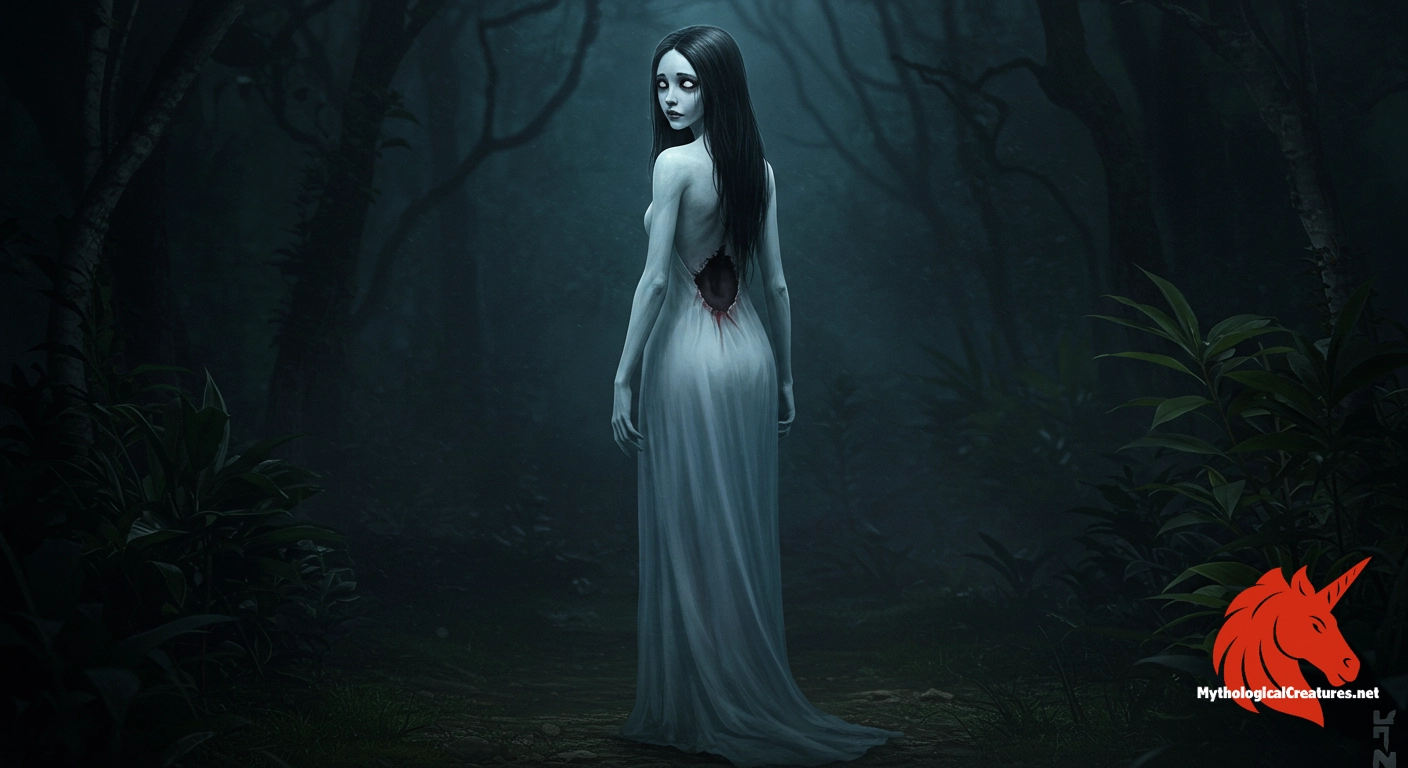Sundel bolong: Sundel Bolong is a mythical Indonesian ghost known for her beauty, long black hair, and ghostly white dress.

Sundel bolong
Sundel bolong - Serves as a cautionary tale about the consequences of societal marginalisation and a symbol of tragic revenge.
Origins & First Encounters
The sundel bolong stands as one of Indonesia’s most evocative and haunting figures, encapsulating themes of beauty, sorrow, and retribution. Born from a mixture of folklore and oral tradition, her origin is entwined with tragic tales of a woman who suffered an untimely and ignoble fate. Her story, though rooted in the past, reflects complex cultural attitudes towards femininity and morality. Across various local legends, she is portrayed as both a cautionary emblem and a figure of enduring empathy. Her spectral presence in Indonesian myth offers a glimpse into a world where social marginalisation meets supernatural vengeance. In many narratives, she is depicted as a beautiful, ethereal woman whose appearance belies the horror that lies beneath. The very image of the sundel bolong, with her long flowing hair and distinctive attire, is tightly interwoven with notions of tragic loss and societal scorn. Her legacy, passed down through generations, serves as both a moral lesson and a mirror to the community’s historical attitudes toward women and their struggles.
Source Texts & Tale Variants
The earliest mentions of the sundel bolong can be traced to a rich tapestry of oral storytelling and local folklore in the Indonesian archipelago. Multiple variants of her tale have been preserved in the spoken word by village elders, each adding subtle layers of detail and moral reflection. Historical manuscripts and traditional texts, though not rigorous in academic stylistic forms, intermittently reference a spectral female figure marked by a striking imperfection. Over time, these stories have been adapted to suit different audiences, with some retellings emphasising her role as a moral guardian while others portray her as an omen of misfortune. In regional literary circles, her character often appears alongside other supernatural entities, contributing to a broader narrative about retribution and societal punishment. Each version of her story, whether recounted by storytellers in rural communities or adapted into modern cinematic expressions, underlines the symbolic significance of her tragic past. Even contemporary Indonesian horror films have reimagined her legacy, merging traditional aesthetics with modern narrative twists. Overall, the sundel bolong’s tale demonstrates the fluidity of myth, as it evolves with each new retelling while keeping its core elements intact.
Form & Powers
The physical portrayal of the sundel bolong is as striking as it is macabre, blending alluring beauty with elements of the grotesque. She is typically depicted as a woman with silky, long black hair that cascades elegantly, lending her an almost hypnotic presence. Her attire is a long, pristine white dress that seems to glow with an otherworldly radiance, yet it is tainted by the sorrow and despair intrinsic to her being. The most notorious aspect of her appearance is the gaping hole on her back, a feature that symbolizes both a physical and emotional void born of her tragic life. This horrid mark serves as a constant visual reminder of the violation and loss that contributed to her spectral curse. While her overall form exudes an ethereal grace, the contrast provided by the hole instils a sense of foreboding in those who encounter her. In some depictions, the hole is rendered as a subtle scar, while in others it is dramatically exaggerated, emphasising the supernatural horror inherent in her legend. Her eyes, often portrayed as deeply melancholic, seem to echo the pain of a life marred by societal rejection. The meticulous attention to these contrasting details—beauty intertwined with decay—ensures that her image remains both captivating and terrifying.
Regional Faces
Throughout Indonesia, regional variations of the sundel bolong myth highlight how local culture and history can mould a universal legend. In Java, for example, the figure is often recounted as a tragic spirit who suffered from deep rejection and poverty, with her appearance serving as a somber reminder of social injustice. On other islands, storytellers have integrated elements of indigenous belief systems with the darker aspects of her character, sometimes linking her transformation to specific local rituals or curses. In some rural communities, the sundel bolong is less a malevolent force and more a lamenting spirit whose actions are driven by unresolved sorrow and injustice. There are even tellings where her image overlaps with that of similar entities like the pontianak, blurring the boundaries between distinct ghostly figures in Southeast Asian folklore. Regional adaptations frequently vary in the description of the infamous hole, with some emphasising mystical symbols and others highlighting its grisly appearance. Local art and performances, including traditional dance and shadow puppet theatre, occasionally feature her narrative, lending her myth a culturally specific flavour. These varied portrayals exemplify how a single figure can serve as a dynamic cultural symbol, adapted to the values and anxieties of different communities across the archipelago.
Cultural Parallels
The sundel bolong shares intriguing similarities with other female apparitions in Southeast Asian mythology, inviting a comparative dialogue between different cultural narratives. Her spectral nature and tragic backstory resonate with the legends of the pontianak in Malaysia and the kuntilanak found in neighbouring traditions, where beauty and malevolence coexist in haunting harmony. These figures often serve to illustrate the consequences of societal ostracisation and the peril of unfulfilled desires. Like these Eastern ghosts, the sundel bolong embodies the bittersweet fusion of allure and repulsion, symbolically linking external beauty with inner torment. A recurring motif across these myths is the visual hallmark of injury or mutilation—be it a gaping wound or a scar—which underscores the theme of violation and unhealed trauma. In many ways, the similarities between these stories point to a regional preoccupation with the costs of marginalisation, particularly for women who transgress or defy societal norms. This intersection of beauty, tragedy, and the spectral has parallels even in Western ghost lore, where figures like the weeping woman similarly encapsulate the interplay of love, loss, and retribution. Observing these cross-cultural echoes enriches the understanding of the sundel bolong, underscoring her role as part of a broader tapestry of myth that vividly illustrates human vulnerability and the enduring consequences of injustice.
Legacy & Modern Evolution
Over time, the sundel bolong has transformed significantly from a cautionary tale of moral degradation into a multifaceted icon within modern Indonesian culture. Traditionally passed down through oral tradition as a spectral warning, her story has been reimagined in literature, film, and popular theatre, adapting to the evolving social landscape. Modern portrayals often imbue her character with feminist undertones, exploring themes of exploitation and the stigmatic treatment of women in society. Contemporary adaptations frequently recontextualise her tale to critique modern societal issues, allowing her to be seen both as a victim and as an empowered figure in the aftermath of injustice. The evolution of her character from a simple ghost story into a complex narrative has sparked discussions among cultural critics and enthusiasts alike. Artistic expressions, ranging from graphic novels to digital art installations, further underscore her relevance in the modern era. Her image, replete with both beauty and horror, continues to be a potent emblem in Indonesian pop culture and has even inspired festivals and commemorative exhibitions. Today, the sundel bolong remains a testament to the enduring power of myth, symbolising the timeless connection between history, societal reflection, and the creative imagination.
Interesting Fact
One intriguing aspect of Sundel Bolong is that while she is typically portrayed as malevolent, some modern interpretations view her as a tragic representation of the societal mistreatment and marginalisation of women.
Quick Creature Info
Origin:
Our Mythic Legendary Rating:

Habitat:
Supernatural Powers:
Physical Attributes:
Abilities:
Behavior:
Weaknesses:
Lore:
Related Creatures, Tales or Lore
- PPontianak
- KKuntilanak
- PPocong
References
Discover Another Mythical Legend You May Not Have Heard Of?
Uncover the mysteries of ancient folklore and expand your knowledge of legendary beings from cultures around the world.
Dare to Meet the Sisyphus....
Mythical Disclaimer: The images and data on this site are derived from various historical and literary sources, but we have found that many myths often have multiple versions and interpretations across references, sometimes contradictory. As a result, these creature depictions are artistic interpretations—imaginative blends of folklore, legend, and a dash of AI guesswork. Because creature descriptions vary widely, our illustrations and accompanying information represent our best effort to honor mythology while bridging creative gaps. Enjoy these interpretations—just remember, we've done our best to respect the stories and validate available data, but in the realm of mythology, details often shift, imagination leads the way, and nothing is ever set in stone!
Curated by the Mythological Creatures Team (rev. May 2025)
